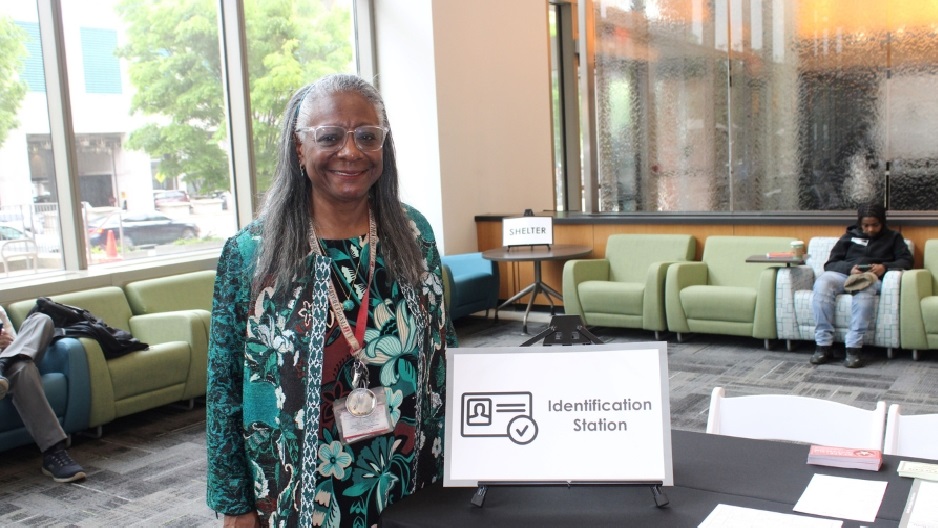“Often, someone in the healthcare system is the first person a formerly-incarcerated individual interacts with after being released from prison,” says Jacqueline C. Romero, U.S. Attorney for the Eastern District of Pennsylvania.
That’s why it’s so important that healthcare workers understand the significant challenges that these individuals face, and develop a compassionate, trauma-informed approach to their treatment. To provide a closer look at what it’s like to return from prison, the Lewis Katz School of Medicine at Temple University—led by Valerie Armstead, MD, MAUB, FAAP, DABA, FASA, Professor of Anesthesiology—hosted a two-hour reentry simulation on May 6.
The event was sponsored by the U.S. Attorney’s Office for the Eastern District of Pennsylvania, as well as the Center for Urban Bioethics at the Lewis Katz School of Medicine, Temple’s Department of Anesthesiology, and the Inside-Out Center at Temple University. It was the first reentry simulation to be held at a Philadelphia healthcare institution, and participants included Temple residents, fellows, and medicals students, as well as Temple Health employees and community members.
Exploring Limitations, Building Empathy
Before the simulation began, Amy J. Goldberg, MD, FACS, The Marjorie Joy Katz Dean of the Lewis Katz School of Medicine, stressed that the event would “underscore the significance of holistic approaches to healthcare and the need for compassion in working with our patients and community.”
As the simulation started, it became clear how it would foster that empathy. Each participant was given a ‘wallet’ with a new identity: that of a formerly-incarcerated individual who had just been released from prison. Participants then had to complete a series of tasks at tables manned by volunteers: obtain government-issued ID documents, find transportation, secure housing, purchase food, get a job, and pay rent, child support, and restitution.
That might sound easy, but given the obstacles faced by many recently-incarcerated individuals, these tasks could become extraordinarily difficult. Participants who couldn’t afford reliable transportation arrived late to their court-mandated rehab, and were denied treatment. That landed them in trouble with their parole officers, and put them at risk of going back to jail. Other participants couldn’t secure benefits because they didn’t have the right documents, or were rejected from jobs or housing because of their past convictions.
Over and over, participants expressed their frustration, and were encouraged to record their feelings on a large notepad in the back of the room. Those who had hit their limit could “take a chance” by getting involved in illegal activities like selling drugs or committing robbery—which offered them a way to make money without the red tape, but could also (and in many cases did) put them back in jail.
Meeting Patients Where They Are
After the simulation ended, participants gathered to talk through their experiences in a wrap-up discussion.
“How many people felt overwhelmed?” asked Cynthia Zuidema, Director of Reentry & Prevention Programs for the U.S. Attorney’s Office. “Frustrated? Stressed?” Everyone in the room raised their hands.
“My biggest challenge was trying to get some kind of respect from the people I interacted with,” said one of the participants. “They weren’t compassionate. They didn’t listen to my concerns.”
“Physicians, nurses, you might be the first person to show empathy to someone who’s just been released from prison, and to meet them where they are,” Maurice Jones, Co-Founder and General Manager of the non-profit PAR Recycle Works, who was helping facilitate the simulation, said. “Or you might continue the cycle of treating them how they’ve already been treated.”
“That’s why I wanted to bring this simulation here: because it’s going to do so much to increase our empathy and understanding,” Dr. Armstead explained. “To the providers in the audience: I hope this will help you relate to your patients who’ve been incarcerated, and communicate with them more effectively. All of this will lead to better outcomes and experiences for our patients.”
Her comments echoed what Dr. Goldberg had told the attendees at the start of the event. “Let’s strive to create a more compassionate and inclusive healthcare system,” Dr. Goldberg said. “One that uplifts all individuals, regardless of their past experiences.”

